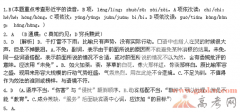浙江省象山普通高中2014届高三第二次模拟英语试题答案(4)
2013-09-21 15:22:54
41. For a newly-established business, bum rate refers to___________.
A.the salary it pays to its staff B. the interest it pays to the bank
C. the way in which it raises capital D.the speed at which it spends money
42. By "Angel money", the author refers to__________.
A. the money borrowed from banks B. the money spent to promote sales
C.the money raised from close friends D.the money needed to start a business
43. To get help from a venture-capital company, you may have to__________.
A.put up with unfair terms B.change your business line
C.enlarge your business scope D.let them operate your business
44. The author easily built a team for his company because__________.
A.they were underpaid at their previous jobs
B.they were turned down by other companies
C.they were confident of the author and his business
D.they were satisfied with the salaries in his company
45. Louise decided to lend money to the author because__________.
A.she wanted to join his company B.she knew he would build a team
C.she knew his plan would succeed D.she wanted to help promote his sales
B
The economic growth that many nations in Asia and increasingly Africa have experienced over the past couple of decades has transformed hundreds of millions of lives – almost entirely for the better. But there’s a byproduct to that growth, one that’s evident – or sometimes less than evident – in the smoggy, smelly skies above cities like Beijing, New Delhi and Jakarta. Thanks to new cars and power plants, air pollution is bad and getting worse in much of the world, and it’s taking a major toll (伤亡人数,代价) on global health.
How big? According to a new analysis published in the Lancet, more than 3.2 million people suffered deaths from air pollution in 2010, the largest number on record. That’s up from 800,000 in 2000. And it’s a regional problem: 65% of those deaths occurred in Asia, where the air is choked by diesel soot (内燃发动机烟雾) from cars and trucks, as well as the song from power plants and the dust from endless urban construction. In East Asia and China, 1.2 million people died, as well as another 712,000 in South Asia, including India. For the first time ever, air pollution is on the world’s top – 10 list of killers, and it’s moving up the ranks faster than any other factor.
So how can air pollution be so damaging? It is the very finest soot – so small that it roots deep within the lungs and from the enters the bloodstream – that contributes to most of the public – health toll of air pollution including death. Diesel soot, which can also cause cancer, is a major problem because it is concentrated in cities along transportation zones affecting overpopulated areas. It is thought to contribute to half the deaths from air pollution in urban centers. Fro example, 1 in 6 people in the U.S. live near a diesel – pollution hot spot like a rail yard, port terminal or freeway.
We also know that air pollution may be linked to other non – deadly diseases. Fortunately in the U.S. and other developed nations, urban air is for the most part cleaner than it was 30 or 40 years ago, thanks to regulations and new technologies like the catalytic converters (催化式排气净化器) that reduce automobile emissions. Govemments are also pushing to make air cleaner – see the White House’s move last week to further tighten soot standards. It’s not perfect, but we’ve had much more success dealing with air pollution than climate change.
Will developing nations like India eventually catch up? Hopefully – though the problem may get worse before it gets better. The good news is that it doesn’t take a major technological advance to improve urban air. Switching from diesel fuel to unleaded (无铅燃油) helps, as do newer and cleaner cars which are less likely to send out pollutants. Power plants – even ones that burn mineral fuels like coal – can be fitted with pollution – control equipment that, at a price, will greatly reduce smog and other pollutants.
But the best solutions may involve urban design. In the Guardian, John Vidal notes that Delhi now has 200 cars per 1,000 people, far more than much richer Asian cities like Hong Kong and Singapore. Developing cities will almost certainly see an increase in care ownership as residents become wealthier – and that doesn’t have to mean deadly air pollution. Higher incomes should also lead to tougher environmental regulations, witch is exactly what happened in the West. We can only hope it happens before the death toll from bad air gets even higher.
46.What tends to give rise to the highest death toll according to the passage?
A.The lack of tight environmental protection standards.
B.The increasing numbers of the diesel cars and trucks.
C.The frighteningly high death rate from deadly cancer.
D.The world’s serious air pollution such as soot and dust.
47.The “byproduct” (Paragraph 1) most probably refers to .
A.consequence B.solution C.reform D.design
48.The basic reason why so many people die from air pollution is that .
A.the diesel soot is too small to be seen
B.the diesel soot is much too poisonous to breathe
C.the diesel soot roots in lungs and gets into blood
D.the diesel soot can also contribute to deadly cancer
49.According to the passage, the writer actually wants to convince the readers that .







